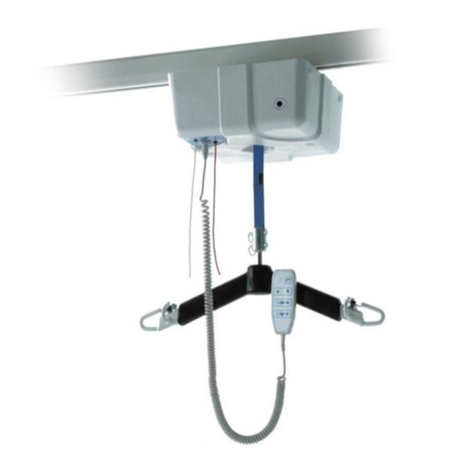English
294000.10017 Rev. B
4
2. INTRODUCTION: ABOUT YOUR LIFT
The Oxford/Hoyer Stature is an electrically operated patient lift. Each Stature lift is
fully assembled load tested and certified before being packed/shipped.
The packing consists of a strong, purpose built carton that is used for both export and
domestic markets to ensure the safe arrival of the lift.
A number of documents are supplied in a wallet which is packed with each lift and
should be kept safely for future reference.
• USER MANUAL • CUSTOMER SATISFACTION CARD (Europe only)
• TEST CERTIFICATE • DEALER GUARANTEE CARD (Europe only)
• PACKING CHECK LIST
The TEST CERTIFICATE is an important document and may be required for your insurance
records. It is valid for six months and after it has expired the lift should be inspected
and serviced per the maintenance schedule by a competent authorised engineer.
Servicing and periodic testing can be carried out by your authorised supplier. Please
ensure your lift is included in their maintenance schedule. If you are at all unsure
what your local market servicing requirements are, please check with your dealer
and/or a local government agency.
The Oxford/Hoyer Stature is suitable for the following CATEGORIES of lift within the
working parameters of the lifts specified in the TECHNICAL SPECIFICATIONS (see con-
tents page).
Category A - Wheelchair
Category B - Bed
Category C - Bath (dependent upon setting)
Category D - Toilet/Shower Chair
Category E - Floor
Category F - 90 degree Rotation
The Oxford/Hoyer Stature is suitable for patients in the SITTING, SITTING/RECUMBENT
and RECUMBENT positions. The slings suitable for this device are listed as follows:
• Oxford/Hoyer Quick fit sling • Oxford/Hoyer Full back sling
• Oxford/Hoyer Quick fit deluxe sling • Oxford/Hoyer Long seat sling
• Oxford/Hoyer Access sling • Oxford/Hoyer Four point comfort sling & pad
The CE mark:
The Oxford/Hoyer Stature carries the CE mark and complies
with the following EC directives:
• Medical Device Directive (93/42/EEC)
• EMC Directive (89/336/EEC)
• Low Voltage Directive (73/23/EEC)





























